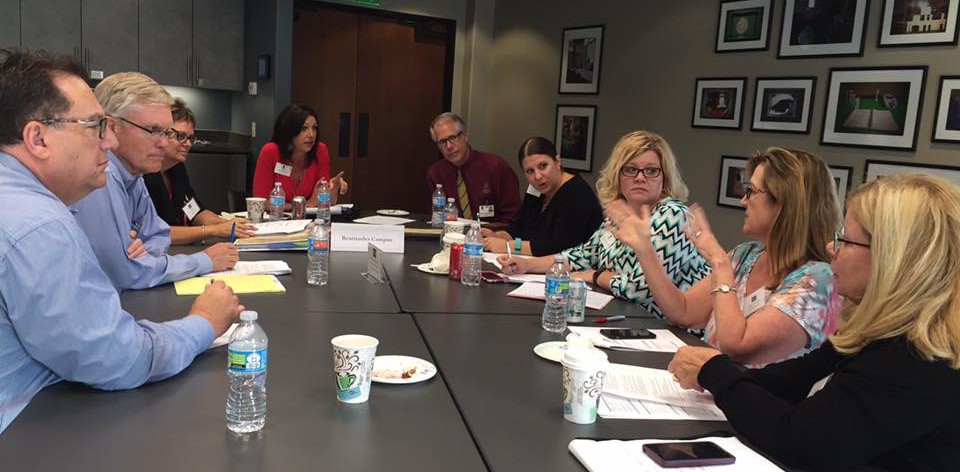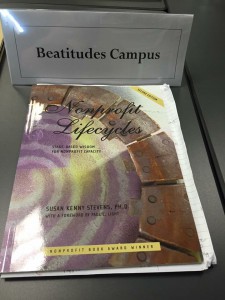The Arizona Interfaith Movement (AZIFM) holds the Golden Rule Banquet each year where people and organizations are honored for upholding the principles of the Golden Rule. I had the pleasure of attending the 14th annual banquet on Thursday evening, April 11, at the Mesa Convention Center and found it an awesome and inspiring evening. Those of us attending from Beatitudes Campus, besides myself, were Sybil Eppinger (whose husband Dr. Paul Eppinger founded the AZIFM), Karen Shannon, Cammy Clevenger, Bob Van Riper and Nancy Splain.
When we arrived at the Mesa Convention Center, we were greeted in the courtyard by hosts at several booths providing information about different religions. At the Sikh booth, I met Rani Sodhi, the brother of the man who was murdered in Mesa right after 9/11. Mr. Sodhi has spent all of the intervening years since then, travelling all over the United States and beyond, working to build bridges of understanding among people of different faiths and backgrounds.
At 6:30PM, we joined the over 800 other attendees inside for the evening program and banquet.
The evening started with the sounding of the Jewish Shofar followed by a welcome from Anita Rangaswami, Vice President of the AZIFM Board and a representative of the Hindu faith.
Pat McMahon, radio personality and Hall of Fame Broadcaster, was Master of Ceremonies for the evening.
Opening prayers were given by a Christian, someone from the BahaIi faith tradition, someone from Family Federation for World Peace and Unification, and a Buddhist. Each prayer ended with the statement of the Golden Rule as expressed in their respective faith traditions.
Mesa’s Mayor, John Giles, and AZIFM’s Executive Director, Rev. Larry Fultz, each then welcomed us, and dinner was served. During dinner, we were treated to an impressive musical performance by Taiko drum artist, Ken Koshio, and his son.
After dinner, the awards were given as the next part of the program. This year’s Golden Rule Awards recipients were as follows:
The Serving the Children Award went to Sunshine Acres, a home for children with no place to go.
The Humanitarian Award went to members of the Japanese American Citizens League made up of Japanese Internment survivors. This group talks to schools and encourages the breakdown of fear and hatred and the empowerment of kindness.
The Community Building Award went to the East Valley Community Builders. This group encourages interracial and social activities between citizens and police to encourage mutual understanding.
The Media Award went to AZTV and its director, Lynn Londen, for programming focusing on the positive qualities of our community, including airing a teenage group which does a media show on kindness and helpfulness.
The Darl Anderson Award went to Nick Lowery, the Hall of Fame Kicker of the Kansas City Chiefs. He started the Nick Lowery Youth Foundation that assists homeless youth.
At the end of the award ceremony, to bring the evening to a close, AZIFM Executive Director, Rev. Larry Fultz, called his family members in attendance to the stage. Assembling on the stage were a husband and wife from Nigeria (the husband had been a young student sent by his father to study in America who had lived with the Fultz’s during that time), a Jewish rabbi, Rev. Fultz’s brother and his Russian wife, a son with his Japanese wife, and a grandson with his Pakistani wife. Each gave a prayer or blessing to us all in his or her native language, followed by his or her spouse’s rendering the prayer in English. What a powerful visual.
The family closing was a magnificent end to a very inspiring evening.









 At last Wednesday’s Town Hall, I had the opportunity to share some exciting news. I announced the campus has been invited to participate in a very successful two-year program offered to eight past grantees of the Virginia G. Piper Charitable Trust. The program, ATLAS, is designed to strengthen and sustain the operating capacity of Trust-identified nonprofits who play important roles in Maricopa County’s human service, civic and cultural life.
At last Wednesday’s Town Hall, I had the opportunity to share some exciting news. I announced the campus has been invited to participate in a very successful two-year program offered to eight past grantees of the Virginia G. Piper Charitable Trust. The program, ATLAS, is designed to strengthen and sustain the operating capacity of Trust-identified nonprofits who play important roles in Maricopa County’s human service, civic and cultural life. Piper Trust has a history of proactively leading and developing programs intended to further strengthen nonprofit organizations so they can serve the community’s ever growing needs. We have been blessed with two grants from Piper Trust over the years. The first in 2002 to fund our initial redevelopment work, then again in 2011 to launch a new program in our organization, Beatitudes Home Health.
Piper Trust has a history of proactively leading and developing programs intended to further strengthen nonprofit organizations so they can serve the community’s ever growing needs. We have been blessed with two grants from Piper Trust over the years. The first in 2002 to fund our initial redevelopment work, then again in 2011 to launch a new program in our organization, Beatitudes Home Health.
 I’m sure we all know what a manila folder is right? I’ll even bet a few old school diehards still use them today. The word Manila actually refers to the manila hemp that they were originally made from. These days they also come in the form of strings of ones and zeros grouped together in a computer’s memory representing an image of what we have always known and recognized. By itself it does nothing more than hold a few papers which are likely related to a similar topic. But combine them with tabs, dividers, larger folders, drawers and file cabinets and you have what is the most common means of record storage of this century. If you don’t believe me go look in Accounting. The same can be done on your computer and even influenced the way computers are set up today.
I’m sure we all know what a manila folder is right? I’ll even bet a few old school diehards still use them today. The word Manila actually refers to the manila hemp that they were originally made from. These days they also come in the form of strings of ones and zeros grouped together in a computer’s memory representing an image of what we have always known and recognized. By itself it does nothing more than hold a few papers which are likely related to a similar topic. But combine them with tabs, dividers, larger folders, drawers and file cabinets and you have what is the most common means of record storage of this century. If you don’t believe me go look in Accounting. The same can be done on your computer and even influenced the way computers are set up today.